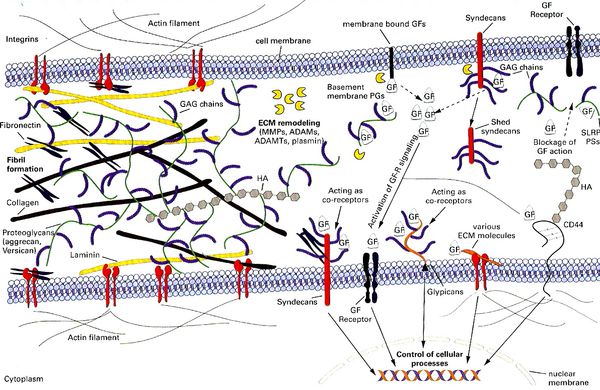
Extracellular Matrix (Ecm) Pathobiology

The Extracellular Matrix (ECM) is a complex network of macromolecules which fills the extracellular space in tissues and provides a molecular scaffold for cell growth, migration, differentiation and survival. Cells bind to ECM by means of many specific cell-membrane receptors and molecules with different affinities and these interactions transmit various signals within cells which affect gene expression and cellular responses. Moreover, ECM provide numerous docking sites for bioactive molecules such as cytokines, growth factors, enzymes and / or inhibitors. It follows that the enzymatic cleavage of the ECM molecules causes a remodeling of the extracellular milieu as well as the release of these bioactive mediators. ECM remodeling occurs in physiological (e.g. during the embryonal development) and pathological situations and involves several proteases such as matrix metalloproteinases (MMPs), plasminogen activators, cysteine proteases and glycosaminoglycans(GAGs)-degrading enzymes such as hyaluronidase and heparanase. ECM pathobiology Unit headed by Prof.Onisto deals with the study of ECM remodeling during tissue repair and various pathological processes. In particular, in the last years, the research activities focus on the study of heparanase, the unique and specific endoglycosidase capable of cleaving heparan sulfate (HS) chains. HS cleavage results in remodelling of ECM as well as in regulating the release of many HS-linked molecules such as growth factors, cytokines and enzymes involved in inflammation, wound healing and tumour invasion.
People
Faculty
- Maurizio ONISTO - Associate Professor
- Valentina MASOLA - Assistant Professor
- Nicola GRECO - PhD Student
Five recent publications
- Slongo ML, Molena B, Brunati A, Frasson M, Gardiman M, Carli M, Perilongo G, Rosolen A, Onisto M. (2007). Functional VEGF and VEGF receptors are expressed in human medulloblastomas. Neuro Oncol. 9 (4), 384-392.
- Masola V, Gambaro G, Tibaldi E, Brunati AM, Gastaldello A, D’Angelo A, Onisto M., Lupo A. (2012). Heparanase and syndecan-1 interplay orchestrates fibroblast growth factor-2-induced epithelial-mesenchymal transition in renal tubular cells. J Biol Chem, 287 (2), 1478-1488.
- Masola V, Zaza G, Secchi MF, Gambaro G, Lupo A, Onisto M. (2014). Heparanse is a key player in the renal fibrosis by regulating TGF-b expression and activity. BBA-Molecular Cell Research, 1843, 2122-2128.
- Secchi MF, Crescenzi M, Masola V, Russo FP, Floreani A, Onisto M. Heparanase and macrophage interplay in the onset of liver fibrosis. Sci Rep. 2017 Nov 2;7(1):14956. doi: 10.1038/s41598-017-14946-0.
- Masola V , Zaza G , Gambaro G, Franchi M , Onisto M. Heparanase in Extracellular Matrix (ECM) remodeling during tumor progression: molecular aspects and therapeutic options. Seminars in Cancer Biology 2020, Volume 62, Pages 86-98, ISSN 1044-579X.




